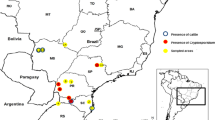Abstract
There are three Echinococcus species, Echinococcus granulosus, E. multilocularis, and E. shiquicus, which are distributed on the vast area of pastureland on the eastern Tibetan plateau in China. Tibetan foxes (Vulpes ferrilata) have been determined to be the main wild definitive host of E. multilocularis and E. shiquicus, but little information is available on the prevalence of these two parasites in Tibetan foxes. Consequently, the copro-prevalence of these parasites in foxes from the eastern Tibetan plateau was evaluated in this study. For each copro-DNA sample extracted from fox feces, a 133-bp segment of EgG1 Hae III was used to screen for infection with E. granulosus. Multiplex nested polymerase chain reaction (PCR) analysis was used to target an 874-bp segment of the mitochondrial COI gene to distinguish E. multilocularis and E. shiquicus. Among 184 fecal samples, 120 were from Tibetan foxes and six from red foxes (Vulpes vulpes). Of the fecal samples from Tibetan foxes, 74 (giving a copro-prevalence of 62 %) showed the presence of Echinococcus spp.: 23 (19 %) were found to contain E. multilocularis, 32 (27 %) E. shiquicus, and 19 (16 %) showed mixed infection with both E. multilocularis and E. shiquicus. Two fecal samples from red foxes were found to be infected with E. multilocularis. No fox feces were found to be infected with E. granulosus. Tests on zinc finger protein genes and a 105-bp fragment of the Sry gene found no significant difference in the prevalence of the two parasites between sexes. The efficiency of our multiplex nested PCR methods were compared with previous polymerase chain reaction-based restriction fragment length polymorphism (PCR-RFLP) methods and some problems associated with the copro-PCR were discussed.



Similar content being viewed by others
References
Abbasi I, Branzenburg A, Campos-Ponce M, Abdel Hafez SK, Raoul F, Craig PS, Hamburger J (2003) Copro-diagnosis of Echinococcus granulosus infection in dogs by amplification of a newly identified repeated DNA sequence. Am J Trop Med Hyg 69:324–330
Asch VB, Alves C, Santos L, Pinheiro R, Pereira F, Gusmao L, Amorim A (2010) Genetic profiles and sex identification of found-dead wolves determined by the use of an 11-loci PCR multiplex. Forensic Sci Int Gen 4:68–72
Bohline JH, Waits LP (2011) Assessing the prevalence of hybridization between sympatric Canis species surrounding the red wolf (Canis rufus) recovery area in North Carolina. Mol Ecol 20:2142–2156
Boufana BS, Campos-Ponce M, Naidich A, Buishi I, Lahmar S, Zeyhle E, Jenkins DJ, Combes B, Wen H, Xiao N, Nakao M, Ito A, Qiu JM, Craig PS (2008) Evaluation of three PCR assays for the identification of the sheep strain (genotype 1) of Echinococcus granulosus in canid feces and parasite tissues. Am J Trop Med Hyg 78:777–783
Budke CM, Campos-Ponce M, Qian W, Torgerson PR (2005) A canine purgation study and risk factor analysis for echinococcosis in a high endemic region of the Tibetan plateau. Vet Parasitol 127:43–49
Casulli A, Manfredi MT, La Rosa G, Di Cerbo AR, Dinkel A, Romig T, Deplazes P, Genchi C, Pozio E (2005) Echinococcus multilocularis in red foxes (Vulpes vulpes) of the Italian Alpine region: is there a focus of autochthonous transmission? Int J Parasitol 35:1079–1083
Craig PS, McManus DP, Lightowlers MW, Chabalgoity JA, Garcia HH, Gavidia CM, Gilman RH, Gonzalez AE, Lorca M, Naquira C, Nieto A, Schantz PM (2007) Prevention and control of cystic echinococcosis. Lancet Infect Dis 7:385–394
Creel S, Spong G, Sands JL, Rotella J, Zeigle J, Joe L, Murphy KM, Smith D (2003) Population size estimation in Yellowstone wolves with error-prone noninvasive microsatellite genotypes. Mol Ecol 12:2003–2009
Davidson RL, Øines Ø, Madslien K, Mathis A (2009) Echinococcus multilocularis—adaptation of a worm egg isolation procedure coupled with a multiplex PCR assay to carry out large-scale screening of red foxes (Vulpes vulpes) in Norway. Parasitol Res 104:509–514
Deplazes P, Gottstein B, Eckert J, Jenkins DJ, Ewald D, Jimenez-Palacios S (1992) Detection of Echinococcus coproantigens by enzyme-linked immunosorbent assay in dogs, dingoes and foxes. Parasitol Res 78:303–308
Dinkel A, von Nickisch-Rosenegk M, Bilger B, Merli M, Lucius R, Romig T (1998) Detection of Echinococcus multilocularis in the definitive host: coprodiagnosis by PCR as an alternative to necropsy. J Clin Microbiol 36:1871–1876
Dinkel A, Kern S, Brinker A, Oehme R, Vaniscotte A, Giraudoux P, Mackenstedt U, Romig T (2011) A real-time multiplex-nested PCR system for coprological diagnosis of Echinococcus multilocularis and host species. Parasitol Res 109:493–498
Eckert J, Conraths FJ, Tackmann K (2000) Echinococcosis: an emerging or re-emerging zoonosis? Int J Parasitol 30:1283–1294
Giraudoux P, Pleydell D, Raoul F (2006) Transmission ecology of Echinococcus multilocularis: what are the ranges of parasite stability among various host communities in China? Parasitol Int 55:S237–S246
Harrison RL, Barr DJ, Dragoo JW (2002) A comparison of population survey techniques for swift foxes (Vulpes velox) in New Mexico. Am Midl Nat 148:320–337
Hüttner M, Siefert L, Mackenstedt U, Romig T (2009) A survey of Echinococcus species in wild carnivores and livestock in East Africa. Int J Parasitol 39:1269–1276
Jenkins DJ (2006) Echinococcus granulosus in Australia, widespread and doing well! Patasitol Int 55:S203–S206
Jiang WB, Wang XM, Li M, Wang ZH (2011) Identification of the Tibetan fox (Vulpes ferrilata) and the red fox (Vulpes vulpes) by copro-DNA diagnosis. Mol Ecol Resour 11:206–210
Lahmar S, Boufana B, Bradshaw H, Craig PS (2007) Screening for Echinococcus granulosus in dogs: comparison between arecoline purgation, coproELISA and coproPCR with necropsy in pre-patent infections. Vet Parasitol 144:287–292
Li TY, Qiu JM, Yang W, Craig PS, Chen XW, Xiao N (2005) Echinococcosis in Tibetan populations, western Sichuan province, China. Emerg Infect Dis 11:1866–1873
Li TY, Chen XW, Zhen R, Qiu JM, Qiu D, Xiao N, Ito A, Wang H, Giraudouxe P, Sakod Y, Nakao M, Craig PS (2010) Widespread co-endemicity of human cystic and alveolar echinococcosis on the eastern Tibetan Plateau, northwest Sichuan/southeast Qinghai, China. Acta Trop 113:248–256
Li M, Wang XM, Jiang WB, Hua PY, Wang ZH (2011) Isolation and characterization of fifteen microsatellite loci in the Tibetan fox (Vulpes ferrilata). J Genet 90:e82–e85
Mathis A, Deplazes P, Eckert J (1996) Improved test system for PCR-based specific detection of Echinococcus multilocularis eggs. J Helminthol 70:219–222
Mehrabani D, Oryan A, Sadjjadi SM (1999) Prevalence of Echinococcus granulosus infection in stray dogs and herbivores in Shiraz, Iran. Vet Parasitol 86:217–220
Meijer T, Norén K, Hellström P, Dalén L, Angerbjörn A (2008) Estimating population parameters in a threatened arctic fox population using molecular tracking and traditional field methods. Anim Conserv 11:330–338
Morishima Y, Tsukada H, Nonaka N, Oku Y, Kamiya M (1999) Coproantigen survey for Echinococcus multilocularis prevalence of red foxes in Hokkaido, Japan. Parasitol Int 48:121–134
Nakao M, Sako Y, Yokoyama N, Fukunaga M, Ito A (2000) Mitochondrial genetic code in cestodes. Mol Biochem Parasitol 111:415–424
Nakao M, McManus DP, Schantz PM, Craig PS, Ito A (2007) A molecular phylogeny of the genus Echinococcus inferred from complete mitochondrial genomes. Parasitology 134:713–722
Nakao M, Xiao N, Okamoto M, Yanagida T, Sako Y, Ito A (2009) Geographic pattern of genetic variation in the fox tapeworm Echinococcus multilocularis. Parasitol Int 58:384–389
Nakao M, Li TY, Han XM, Ma XM, Xiao N, Qiu JM, Wang H, Yanagida T, Mamuti W, Wen H, Moro PL, Giraudoux P, Craig PS, Ito A (2010) Genetic polymorphisms of Echinococcus tapeworms in China as determined by mitochondrial and nuclear DNA sequences. Int J Parasitol 40:379–385
Nonaka N, Hirokawa H, Inoue T, Nakao R, Ganzorig S, Kobayashi F, Inagaki M, Egoshi K, Kamiya M, Oku Y (2010) The first instance of a cat excreting Echinococcus multilocularis eggs in Japan. Parasitol Int 57:519–520
Ortega J, Franco MR, Adams BA, Ralls K, Maldonado JE (2004) A reliable, noninvasive method for sex determination in the endangered San Joaquin kit fox (Vulpes macrotis mutica) and other canids. Conserv Genet 5:715–718
Qiu J, Chen X, Ren M, Lou C, Liu D, Liu X, He D (1995) Epidemiological study on alveolar hydatid disease in Qinghai-Xizang plateau. J Pract Parasit Dis 3:106–109 [In Chinese with English summary]
Raoul F, Deplazes P, Nonaka N, Piarroux R, Vuitton DA, Giraudoux P (2001) Assessment of the epidemiological status of Echinococcus multilocularis in foxes in France using ELISA coprotests on fox feces collected in the field. Int J Parasitology 31:1579–1588
Stefanic S, Shaikenov BS, Deplazes P, Dinkel A, Torgerson PR, Mathis A (2004) Polymerase chain reaction for detection of patent infections of Echinococcus granulosus (“sheep strain”) in naturally infected dogs. Parasitol Res 92:347–351
Torgerson PR, Deplazes P (2009) Echinococcosis: diagnosis and diagnostic interpretation in population studies. Trends Parasitol 25:164–170
Trachsel D, Deplazes P, Mathis A (2007) Identification of eggs of canine taeniids by multiplex PCR. Parasitology 134:911–920
Tsukada H, Morishima Y, Nonaka N, Oku Y, Kamiya M (2000) Preliminary study of the role of red foxes in Echinococcus multilocularis transmission in the urban area of Sapporo, Japan. Parasitology 120:423–428
van der Giessen JWB, Rombout YB, Franchimont JH, Limper LP, Homan WL (1999) Detection of Echinococcus multilocularis in foxes in The Netherlands. Vet Parasitol 82:49–57
Wang S, Xie Y (2009) China species red list. Higher Education Press, Beijing
Wang H, Schantz PM, Liu FJ, Ito A, Chai JJ (2000) Infections of larval and adult Echinococcus multilocularis in human and animals in Qinghai province. Chinese J Parasit Dis Control 13:120–123 [in Chinese with English summary]
Wang ZH, Wang XM, Liu XQ (2008) Echinococcosis in China, a review of the epidemiology of Echinococcus spp. EcoHealth 5:115–126
Xiao N, Qui JM, Nakao M, Li TY, Yang W, Chen X, Schantz P, Craig PS, Ito (2005) A Echinococcus shiquicus n. sp., a taeniid cestode from Tibetan fox and plateau pika in China. Int J Parasitol 35:693–701
Xiao N, Nakao M, Qiu JM, Budke CM, Giraudoux P, Craig PS, Ito A (2006a) Short report: dual infection of animal hosts with different species of Echinococcus in the eastern Qinghai-Tibetan Plateau region of China. Am J Trop Med Hyg 75:292–294
Xiao N, Qui JM, Nakao M, Li TY, Yang W, Chen XW, Schantz PM, Craig PS, Ito A (2006b) Echinococcus shiquicus, a new species from the Qinghai-Tibet plateau region of China: discovery and epidemiological implications. Parasitol Int 55:S233–S236
Ziadinov I, Deplazesa P, Mathisa A, Mutunovab B, Abdykerimovb K, Nurgazievb R, Torgerson PR (2010) Frequency distribution of Echinococcus multilocularis and other helminths of foxes in Kyrgyzstan. Vet Parasitol 171:286–292
Acknowledgments
We thank Qiu Jiamin, Chen Xingwang, and other colleagues (Sichuan Center of Disease Control, Chengdu, China) for their help with field research. Colleagues from the Shiqu County Center of Disease Control provided us imperative logistical support during the field study. Dr. Wu Wei, Liu Xiaoqing, and Ma Bo (School of Life Science, East China Normal University, Shanghai, China) participated in the fieldwork. We are grateful to reviewers for their invaluable comments to improve this manuscript. This study was financially supported by grants from the National Science Foundation of China (NSFC no. 30870308 and 31071944), the Shanghai Rising-Star Program (STCSM no. 10QA1402200) and East China Normal University Innovative Program of Science Research for Ph.D. candidature (CX2011012).
Author information
Authors and Affiliations
Corresponding authors
Rights and permissions
About this article
Cite this article
Jiang, W., Liu, N., Zhang, G. et al. Specific detection of Echinococcus spp. from the Tibetan fox (Vulpes ferrilata) and the red fox (V. vulpes) using copro-DNA PCR analysis. Parasitol Res 111, 1531–1539 (2012). https://doi.org/10.1007/s00436-012-2993-8
Received:
Accepted:
Published:
Issue Date:
DOI: https://doi.org/10.1007/s00436-012-2993-8




